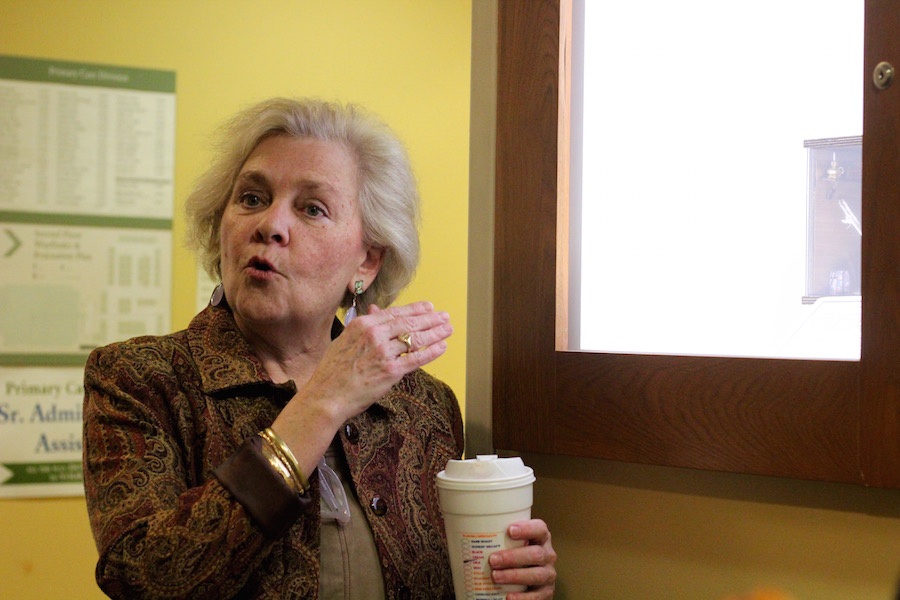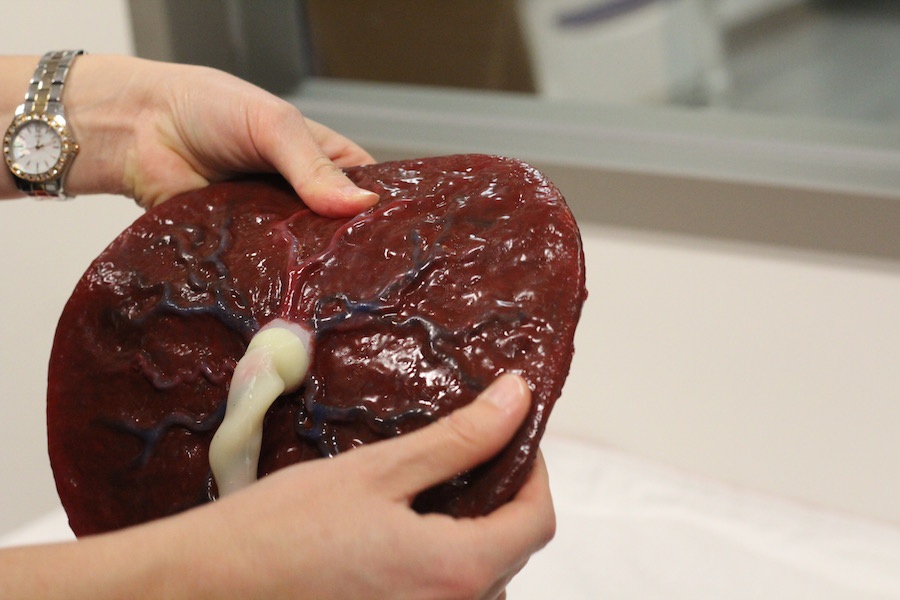.jpg)
Susan Ernst works to intubate her "patient" before it's too late. Lucy Gellman Photos.
Susan Ernst was having trouble intubating her patient. Her hands were steady. From the back of his throat, she could see two small vocal cords. It was his mouth—the small shape of it, teeth and tongue fighting back against the laryngoscope. Until she eased it in, and he could breathe again. She exhaled her own little sigh of relief.
But Ernst isn’t a medical professional. She’s an artist, with a background in mixed media, horticulture, and landscape art. She just happened to be put in a high-stakes medical drama—with a low-stakes rubber patient—and used her powers of close looking to get through it.

Honan showing off miniature dollhouses fashioned by a former dean at the Yale School of Nursing.
Thursday afternoon, Ernst was one of the first Connecticut artists to get a hands on, behind-the-scenes glimpse of this year’s City-Wide Open Studios (CWOS) at the Yale School of Nursing, geared toward wellness and wellbeing.
While the citywide festival will not be held until this fall, Artspace is now seeking project proposals from artists, with enough funding for 10 finished projects.
22 artists attended the tour, which started in the Yale School of Nursing and ended with its network of underground tunnels, which lead to the empty building where CWOS’ “Alternative Space” weekend will be held. Another site visit is scheduled for March 3 (sign up here).
The decision to move to West Campus came after Artspace received news that the Goffe Street Armory, where it has been for five years, is no longer structurally sound enough to host the weekend. Artspace Director Helen Kauder said that the theme of wellbeing had already been knocking around in her skull; the location thrust it further into focus.
“I think wellness was already on our minds because of the political situation, because of the change in healthcare coverage that creates a lot of anxiety, a sense of what artists and we as a community could do to care for each other,” she said, fresh off her time in a simulation lab. “So we were already feeling a need. And then when the building came through … we thought, this is the future of wellness education here. It was a logical step.”

Phil Martinez works with Stephen Urchick.
That step is a two-way street, said Nursing Professor Linda Honan. The only program in the country to take applicants without pre-nursing prerequisites, the School of Nursing gets a lot of nontraditional applicants—artists, former journalists, musicians. Its answer is to hone in on a nontraditional approach starting on day one, as Honan makes plaster casts of students’ hands with them.
From there, she explained that students use the arts to expand their close looking and close listening skills. In one session, they’ll use teachings from the Yale School of Music to train their ears to hear heart sounds, sometimes close to undetectable. In another, they’ll look at the same painting for three hours with a museum educator, pulling out each detail of the work. At the end of that close looking training, Honan said, students have a "100 percent" success rate making diagnoses based on appearance.
“Our students are going to be primary health providers, caring for the underserved,” she said. “We need you to throw the new wide. What we’ve found is that when a science looks to the arts, you help us.”
.jpg)
Veteran nurse Virginia Sherrick with one of the "patients."
Now, both she and Kauder are hoping that sense of helping through the arts will take on new dimensions. As they toured the building, artists split into groups and dove into live simulations. In the first, artists watched a film on cells, watching cell movements and construction as depicted by lego cubes.
In another, artists learned to intubate, standing close to their “patients” until their bodies became angular, arms and backs forming through lines to their laryngoscopes. The room smelled like bleach and sweat.
Ernst struggled. Mentor Phil Martinez stood by, at the ready to assist. As Ernst eased the scope in, Martinez said it’s the same exercise he runs through with nursing students, until they have an intimate feel for what they’re doing.
Ernst, who was well on her way there, said the exercise worked for her within the CWOS theme.
“There’s a spiritual component, a creative component, a natural component,” she said. “It’s part of being a holistic person, and we need all of that to be healthy.”

Sarah Fritchey: “Can you believe a body can make this?”
In two mock hospital rooms nearby, artists examined two lifelike “patients:” a woman who had just given birth, and a man who had come in complaining of pain. Now, a muffled, dog-like cry emanated from his throat with no sign of stopping. Wet streaks pooled beside his eyes.
Across the hall, Artspace curator Sarah Fritchey examined rubbery rope-like placenta and bright red blood clots made with drink thickener as artists passed around a mock baby.
“Can you believe a body can make this?” she exclaimed, asking no one in particular. She thumbed the placenta, the surface giving beneath her thumb, then bouncing back.
“Asking artists and audiences to think about wellbeing opens up conversations around the ways we understand and care for one another, the landscape, and the material world,” she added after the tout. “There seems no better time than the present to reflect on the power that listening and seeing one another, with intention, can have.”